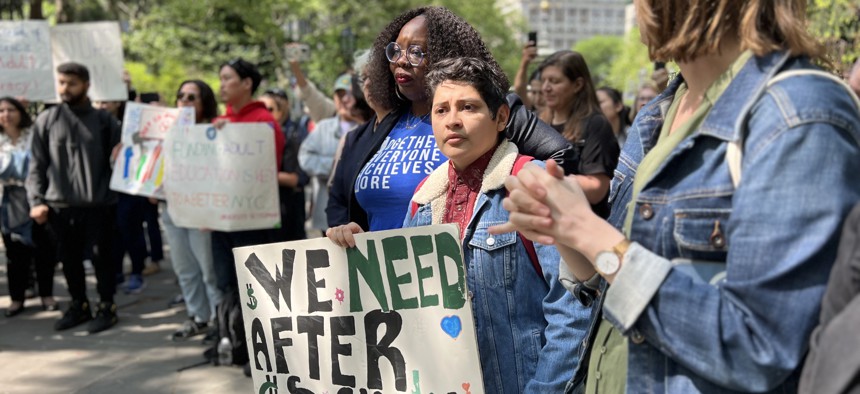Opinion
Opinion: Eric Adams’ proposed budget for youth-related programs won’t meet the demand providers will face
Nonprofits are already being underpaid for the afterschool, summer youth employment and community center services they provide.

New York City Council Member Althea Stevens (center), chair of the youth committee, and Dante Bravo, youth policy analyst at United Neighborhood Houses, participate in a rally protesting cuts to youth services in City Hall Park on May 10, 2023. Photo courtesy of United Neighborhood Houses
Over the last six months, New York City Mayor Eric Adams has called on his commissioners to propose cuts to their agency’s spending three separate times. These cuts – also called Programs to Eliminate the Gap, or PEGs – have added up quickly. The Department of Youth and Community Development, which funds afterschool programs, summer youth employment, and community centers among other popular services, has proposed a nearly $40 million reduction in their program budget since November.
The mayor claims these cuts will have no impact on services, and many of the PEGs are framed as “less than anticipated spending.” Because DYCD contracts with nonprofits to run these programs, in this context, “less than anticipated spending” means that the nonprofits didn’t serve as many kids as they had originally planned. Technically, the city is just recouping unspent funds, not reducing services, allowing the mayor to make his claim that service levels won’t be impacted while reducing program budgets.
What’s odd about the mayor’s PEGs, though, is that they include savings from planned, “less than anticipated spending.” Apparently, three years from now, the mayor’s team has opined that summer youth employment programs will underspend – meaning serve fewer youth – by about $9 million. Same for afterschool and summer camp, which the mayor expects to serve so many fewer kids next year that the city will save almost $30 million. This while the Mayor’s Management Report, which tracks utilization of city-funded programs, notes that these programs continue to fill up quickly. How could this be?
The problem is that many of these programs haven’t been re-contracted for years. Nonprofits that run afterschool programs were recently notified that their contracts will receive a two-year extension – without any budget escalation – on contracts that were originally signed in 2012. A dozen eggs cost about $1.84 in 2012. As each year passes and the cost of everything gets more expensive (a dozen eggs will run you about $4.21 now), it gets harder and harder to serve the same number of kids with the same amount of money. Budgets get stretched further and further, and nonprofits aren’t able to keep up – especially with staffing. Staff vacancy rates at nonprofit youth services organizations have skyrocketed, and it has led to some New York City nonprofits closing classrooms, shortening their hours and reducing services.
It’s time for the Mayor to invest in a robust youth services system that meets the current demand. If waitlists are growing, DYCD’s program budget should be, too. The city shouldn’t balance a budget in anticipation of “less than anticipated spending,” rather should be asking how to expand programs and services to meet the needs of children and families.
Susan Stamler is executive director of United Neighborhood Houses.
